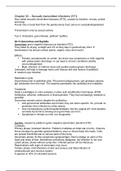Chapter 30 – Sexually transmitted infections (STI)
Also called sexually transmitted diseases (STD), caused by bacteria, viruses, potists
and fungi.
Found only in body fluid from the genitourinary tract (urine en voortplantingsstelsel)
Transmission only by sexual activity
Top 3; chlamydia, gonorrhoeae, pallidum (syfillis)
30.13 Gonorrhea and Syphilis
Gonorrhea; gram negative diplococcus (bacteria STD)
They killed by drying, sunlight and UV so they stay in genitourinary tract
transmission via sexual contact (penis, vagina, anus and mouth)
Effects;
Female; asymptomatic (is carrier, but show now symptones) or mild vaginitis
with yellow-green discharge can lead to chronic conditions sterility
(onvruchtbaarheid)
Male; infection of urethral canal and puslike (yellow-green) discharge
Untreated; will lead to damage heart, joint tissues and skin lesions (huidletsel)
In newborn eye infection.
Replication cycle;
Gonorrhoea bind to epithelial cells. Pili prevent phagocytosis. IgA protease cleaves
IgA antibodies from the host. The bacteria penetrates into epithelial and multiplies.
Treatment;
Swab’s (uitstrijkje) or urine samples; nucleic acid amplification techniques (PCR)
Antibiotics; cefixime, ceftriaxone or fluoroquinoles. They had increasingly resistant to
penicillin.
Gonorrhea remains active despite the antibiotics;
Anti-gonococcal antibodies are formed, they are strain specific. So, provide no
protection from infection by other strains.
Oral contraceptives (anticonceptiemiddelen) rise the vaginal pH. Acid bacteria
normally found fail to develop and gonorrhea can form.
Symptones in female so mild, not recognized.
Syphilis; caused by pallidum (gram-negative spirochete) (bacteria STD)
3 phases;
Primary phase; localized infection. Pallidum multiplies at initial site of entry. Chancre
forms (wondje) by genitals (geslachtsdelen), anus or throat (keel) this heals. Cells
are spread frominitial site to various parts of the body.
Secondary phase; flu-like symptones (griepachtige). Rash (uitslag) on palm of the
head and soles of feet. Sometimes symptones disappear, but infection is not over
Latent phase; phase without sympones. Infected person sill be infectious.
Reactivations with signs of secondary may occur
Tertiary phase; mild infections of skin and serious and fatal infection of
cardiovascular and nervous system.
It appears in 40% of untreated persons.






